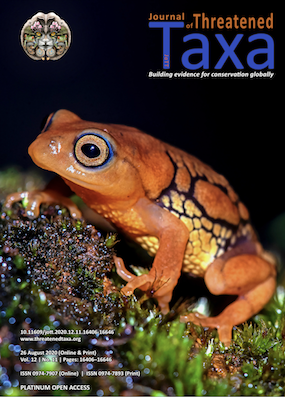Open garbage dumps near protected areas in Uttarakhand: an emerging threat to Asian Elephants in the Shivalik Elephant Reserve
Main Article Content
Abstract
Waste dumping sites near protected areas are a growing issue, which may affect the activities and behaviour of wildlife, more than what we notice. Here, we present two of our case studies, where Asian Elephants were found feeding at garbage dumps in Haridwar and Ramnagar forest divisions in the Shivalik Elephant Reserve in Uttarakhand State. Since garbage dumps may spread bacterial infection and induce adverse changes in the health conditions of the elephant population, we draw the attention of planners to develop a plan of action for proper disposal of the garbage through these preliminary observations, without affecting protected areas and wildlife species, including elephants. Moreover, collection of data on the presence of garbage dumps across the reserve and a study on the behavioural responses of scavenging and non-scavenging animals visiting the dumps would give us a better understanding of the level of impact of garbage dumps for disposal planning. It is to emphasize that garbage does not constitute a part of natural food for elephants. There are restrictions and guidelines in the Indian Wildlife (Protection) Act 1972, Solid Waste Management Rules, 2016 and Guidelines for Declaration of Eco-Sensitive Zones around National Parks and Wildlife Sanctuaries.
Article Details
Authors own the copyright to the articles published in JoTT. This is indicated explicitly in each publication. The authors grant permission to the publisher Wildlife Information Liaison Development (WILD) Society to publish the article in the Journal of Threatened Taxa. The authors recognize WILD as the original publisher, and to sell hard copies of the Journal and article to any buyer. JoTT is registered under the Creative Commons Attribution 4.0 International License (CC BY), which allows authors to retain copyright ownership. Under this license the authors allow anyone to download, cite, use the data, modify, reprint, copy and distribute provided the authors and source of publication are credited through appropriate citations (e.g., Son et al. (2016). Bats (Mammalia: Chiroptera) of the southeastern Truong Son Mountains, Quang Ngai Province, Vietnam. Journal of Threatened Taxa 8(7): 8953–8969. https://doi.org/10.11609/jott.2785.8.7.8953-8969). Users of the data do not require specific permission from the authors or the publisher.
References
Anonymous (2015). Encroachment, illegal construction found at Shyampur range. The Pioneer, 6 February 2015; http://www.dailypioneer.com/state-editions/dehradun/encroachment-illegal-construction-found-at-shyampur-range.html. Accessed on 30 November 2017.
Dunjic, J., V. Stojanovic, M. Solarevic& V. Kicosev (2017). Sustainable waste management in protected areas of Vojvodina, pp. 145-152. In: Hrvojevic, M.P. (ed). Contemporary Trends in Tourism and Hospitality. New Spaces in Cultural Tourism, University of Novi Sad, Vojvodina, Serbia, 272pp.
Fernando, P. & J. Pastorini (2006). Surveying elephants and helping to solve human-elephant conflict in and around Wasgamuwa National Park, Sri Lanka. Expedition report, 61pp. https://www.biosphere-expeditions.org/images/stories/pdfs/reports/report-srilanka05.pdf. Accessed on 30 November 2017.
Ganesan, R. (2016). Dump yard in elephant corridor poses threat to wild animals. Down To Earth, 30 May 2016; http://www.downtoearth.org.in/news/the-dump-yard-that-spells-death-knell-for-wildlife-54117. Accessed on 30 November 2017.
Hardesty, B.D., D. Holdsworth, A. Revill & C. Wilcox (2015). A biochemical approach for identifying plastics exposure in live wildlife. Methods in Ecology and Evolution 6(1): 92–98.
Joshi, R., B.D. Joshi & R. Singh (2007). Population composition of Asian elephant (Elephas maximus) in the Rajaji National Park, Uttarakhand, India. Himalayan Journal of Environment & Zoology 21(2): 189–202.
Katlam, G., S. Prasad, M. Aggarwal & R. Kumar (2018). Trash on the menu: patterns of animal visitation and foraging behavior at garbage dumps. Current Science 115(12): 2322–2326.
Kolahi, M., T. Sakai, K. Moriya, M.F. Makhdoum & L. Koyama (2013). Assessment of the effectiveness of protected areas management in Iran: case study in Khojir National Park. Environmental Management 52(2): 514–530.
Mc Kay, A.F. & B.J. Hoye (2016). Are Migratory Animals Super spreaders of Infection? Integrative and Comparative Biology 56 (2): 260–267. DOI: https://doi.org/10.1093/icb/icw054
MoEF Change (2011). Draft Guidelines for Ecotourism in and around Protected Areas. http://www.moef.nic.in/downloads/public-information/Draft%20Ecotourism%20Guidelines%202%20June.pdf. Accessed on 14 July 2017.
Newsome, T.M. & L.M. van Eeden (2017). The Effects of Food Waste on Wildlife and Humans. Sustainability, 9 :1–9.
Oppili, P. (2016). Elephants break electric fence to get to garbage dump. Times of India, 2 October 2016;https://timesofindia.indiatimes.com/city/chennai/Elephants-break-electric-fence-to-get-to-garbage-dump/articleshow/54635393.cms. Accessed on 30 November 2017.
Plaza, P.I. & S.A. Lambertucci (2017). How are garbage dumps impacting vertebrate demography, health, and conservation? Global Ecology and Conservation 12: 9–20. DOI: https://doi.org/10.1016/j.gecco.2017.08.002
Przydatek, G. (2019). Waste management in selected national parks-a review. Journal of Ecological Engineering 20(4): 14–22.
Rodrigo, M. (2017). Deadly garbage dumps pose elephantine problems. The Sunday Times, 5 March 2017; http://www.sundaytimes.lk/170305/news/deadly-garbage-dumps-pose-elephantine-problems-231517.html. Accessed on 30 November 2017.
Sharma, S. (2015). Haridwar dumps 300 tons of garbage in reserve forest area. The Times of India, 30 January 2015; https://timesofindia.indiatimes.com/city/dehradun/Haridwar-dumps-300-tons-of-garbage-in-reserve-forest-area/articleshow/46070458.cms. Accessed on 26 May 2020.
Uttarakhand Forest Department (2015). Wild Asiatic elephant, population estimation 2015. Report, Wildlife Preservation Organisation, Uttarakhand Forest Department, Uttarakhand, India.
Williams, A.C. (2002). Elephants (Elephas maximus): their habitats in Rajaji-Corbett National Parks, north-west India. PhD Thesis. Saurashtra University, Rajkot, Gujarat, India.

